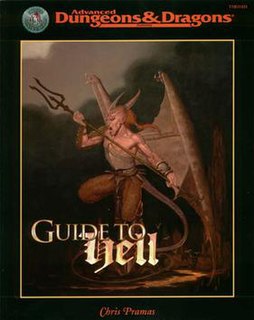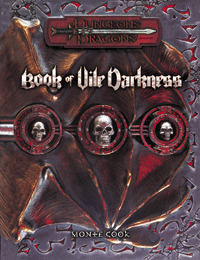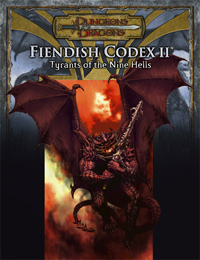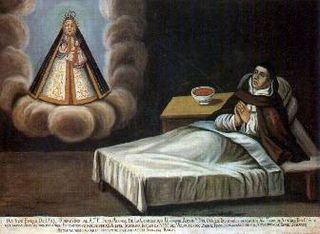Publication history
Geryon first appears in the first edition Monster Manual (1977). [2] Geryon's realm was further detailed in Ed Greenwood's "The Nine Hells Part I" in Dragon #75 (1983). [3]

Ed Greenwood is a Canadian fantasy writer and the original creator of the Forgotten Realms game world. He began writing articles about the Forgotten Realms for Dragon magazine beginning in 1979, and subsequently sold the rights to the setting to TSR, the creators of the Dungeons & Dragons roleplaying game, in 1986. He has written many Forgotten Realms novels, as well as numerous articles and D&D game supplement books.

Dragon was one of the two official magazines for source material for the Dungeons & Dragons role-playing game and associated products; Dungeon was the other.
Geryon did not initially appear in 2nd edition, and in the Planescape line the lord of Stygia was instead a trapped archfiend named Levistus. Eventually, Geryon's fate as a deposed Lord of Hell was revealed in the adventure A Paladin in Hell (1998), [4] and Guide to Hell (1999). [5]

Planescape is a campaign setting for the Dungeons & Dragons fantasy role-playing game, originally designed by Zeb Cook. The Planescape setting was published in 1994. As its name suggests, the setting crosses and comprises the numerous planes of existence, encompassing an entire cosmology called the Great Wheel, as originally developed in the Manual of the Planes by Jeff Grubb. This includes many of the other Dungeons & Dragons worlds, linking them via inter-dimensional magical portals.

Guide to Hell is an accessory for the 2nd edition of the Advanced Dungeons & Dragons fantasy role-playing game, published in 1999.
In third edition, Geryon was given statistics in an online web enhancement for the Book of Vile Darkness (2002) titled "Yet More Archfiends". [6] Geryon appeared as a vestige in Tome of Magic (2006). [7] Geryon received a brief description in Fiendish Codex II: Tyrants of the Nine Hells (2006). [8]

Book of Vile Darkness is an optional supplemental sourcebook for the 3rd edition of the Dungeons & Dragons role-playing game. The book was written by Monte Cook and published by Wizards of the Coast in October 2002. Described as a "detailed look at the nature of evil," it was the first Dungeons & Dragons book labelled for mature audiences. The second was the "good" companion volume Book of Exalted Deeds. Another Book of Vile Darkness was published for the 4th edition of Dungeons & Dragons in 2011.

Tome of Magic is a handbook of rules and guidelines for the Dungeons & Dragons role-playing game. As its name implies, it is a supplement to be used to expand the magical options available in the game. It was first released for Advanced Dungeons & Dragons, 2nd Edition, and the name was reused for a book released for the 3rd Edition of D&D.

Fiendish Codex II: Tyrants of the Nine Hells is an optional supplemental source book for the 3.5 edition of the Dungeons & Dragons roleplaying game.
History
Geryon was once the lord of Stygia, the Fifth Layer of Hell, a position he gained right after the demotion of Levistus.
Known for his staunch loyalty to Asmodeus, Geryon was the only one to support the Lord of Nessus upon the Hell-wide revolution known as the Reckoning of Hell. Yet, in the aftermath, his faithfulness was apparently useless, as Geryon was demoted and banished to Avernus with his court by Asmodeus himself.
He was at one time a commander of a Stygian fortress known as Coldsteel, only to later lose that position as well. His physical form has ultimately been destroyed and his life-essence was given to power up Glasya, Asmodeus's daughter who recently gained the rulership of Malbolge, the Sixth Layer of Baator. Geryon now exists as a vestige. Binders who summon Geryon can gain some of his powers, such as his extra eyes, his baleful gaze and his power of flight, in return risking being influenced by his personality and acquiring his weakness of irrational loyalty.
4th edition
In 4th edition, his backstory is revealed. Geryon was once an angel in the service of He Who Was, and together with six other angels was a mighty force for good. In a terrible battle with a monstrous foe (unidentified but believed to be a primordial), they ultimately won victory, but four of his brother angels were killed, and Geryon and the other two were badly wounded. Realizing that he could not save them all, He Who Was used the other two angels to save Geryon. Originally grateful, Geryon soon realized that he held the memories and thoughts of his brothers within him, and as a result his agony over losing them was constant and eternal. He joined with Asmodeus after being promised that he would be cured of his pain, and although he was never fully healed Asmodeus was able to dull the agony to a minor irritant. His role in the reckoning and the aftermath is unchanged.
Geryon still lives. After he was exiled by Asmodeus, he went to Tytherion and retreated to a cave. He now occasionally serves as a mercenary for powerful mortals and holds infernal pacts with certain warlocks. Lately, he has been haunted with the question of why Asmodeus exiled him after he proved his loyalty. He believes now that Asmodeus wants him to complete a task so terrible, the Lord of Hell did not dare even speak of it and is afraid of being associated with it even by proxy. He thinks that Asmodeus expects him to figure out what to do and handle it, and spends much of his time trying to determine what task would be so terrible that Asmodeus himself was afraid of it. Even if he figures out what he is supposed to do, he is divided as to whether or not to actually do it.
In the Dungeons & Dragons roleplaying game, devils are a powerful group of monsters used as a high-level challenge for players of the game. Devils are Lawful Evil in alignment and originate from the Nine Hells of Baator. True to their Lawful Evil alignment, devils are locked in a strict and brutal hierarchy. At the top of the hierarchy are the supreme Archdevils or Lords of the Nine, who are the rulers of the different regions of Baator. Devils often see the various worlds in the D&D metacosmos as tools to use for their own ends, including prosecuting the Blood War, a millennia-long war between the devils and their arch-enemies, demons.

In the Dungeons & Dragons role-playing game, Glasya is a powerful devil and a Princess of Hell. She is noted to be one of the most powerful and influential of the female devils. Her symbol is a copper scourge.

In the Dungeons & Dragons fantasy roleplaying game, Pazuzu is a powerful demon prince, called the Prince of the Lower Aerial Kingdoms. He rules the skies above all layers of the Abyss. He is sometimes known as Pazrael or Pazuzeus.

Asmodeus is a fictional character from the Dungeons & Dragons roleplaying game. His exact nature varies from publication to publication; he is alternately presented as an evil god or a powerful devil.

In the Dungeons & Dragons roleplaying game, BaalzebulBAYL-zə-bul is a fictional character, described as an Arch-Devil of Hell, also called the "Lord of the Flies."

In many campaign settings for the Dungeons & Dragons fantasy role-playing game, Dispater is an Arch-Devil of Hell, and the Lord of the Iron City of Dis.

In many campaign settings for the Dungeons & Dragons role-playing game, Belial is an Arch-Devil of Hell, lord of the Fourth Hell, Phlegethos. He retained his rule after the Reckoning of Hell, though he now shares this responsibility with his daughter Fierna who serves as his mouthpiece. He has designs on the Fifth and Sixth levels of Hell. His symbols are a two-pronged ranseur and a handsome male face with dark features and small horns. A more elaborate symbol of Belial involves red, glowing eyes over a two-pronged ranseur, surrounded by a red tail with a wicked barb.

In the Dungeons & Dragons roleplaying game, Mammon is an Arch-Devil of Hell, also known as the "Lord of Avarice." His symbol is a pair of red scaled hands open and looming over a black gemstone, or gold medallions emblazoned with the image of a snake-bodied devil.

In the Dungeons & Dragons role-playing game, Mephistopheles is an Arch-Devil of Hell, also known as the "Lord of No Mercy" and the "Cold Lord".

In many campaign settings for the Dungeons & Dragons role-playing game, Moloch is an arch-devil of Hell, and once served as the viceroy of Baalzebul.
In the Dungeons & Dragons fantasy roleplaying game, "rabble of devilkin" is a term applied to the lesser unique outcast devils dwelling on Avernus, the first layer of the Nine Hells.
In the Dungeons & Dragons fantasy role-playing game, the nupperibo is a grossly fat devil, one of the least powerful of its kind.
In the Dungeons & Dragons fantasy roleplaying game, an Aspect is the physical embodiment of a god, demon lord, or other such powerful, godly being sent to the Material Plane to act as a representative of the being itself, for whatever reason.

In the Dungeons & Dragons roleplaying game, Amon, also known as Amon the Wolf, is a deposed Duke of Hell.

In the Dungeons & Dragons roleplaying game, Bael is a powerful Duke of Hell in the service of Mammon.

Hutijin is a powerful Duke of Hell in the service of Mephistopheles, in the Dungeons & Dragons roleplaying game.

Titivilus is Dispater's nuncio, serving as his ambassador and viceroy, and a powerful Duke of Hell, in the Dungeons & Dragons roleplaying game.
This page is based on this
Wikipedia article Text is available under the
CC BY-SA 4.0 license; additional terms may apply.
Images, videos and audio are available under their respective licenses.













